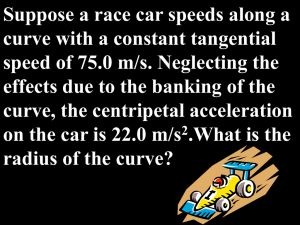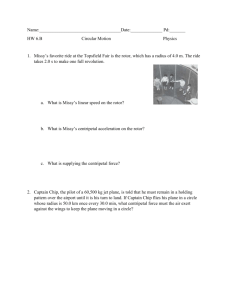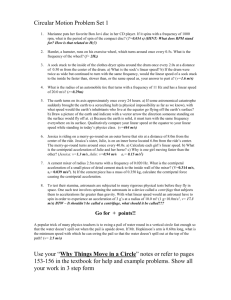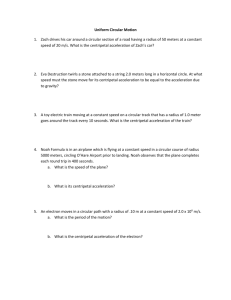Uniform circular motion
advertisement
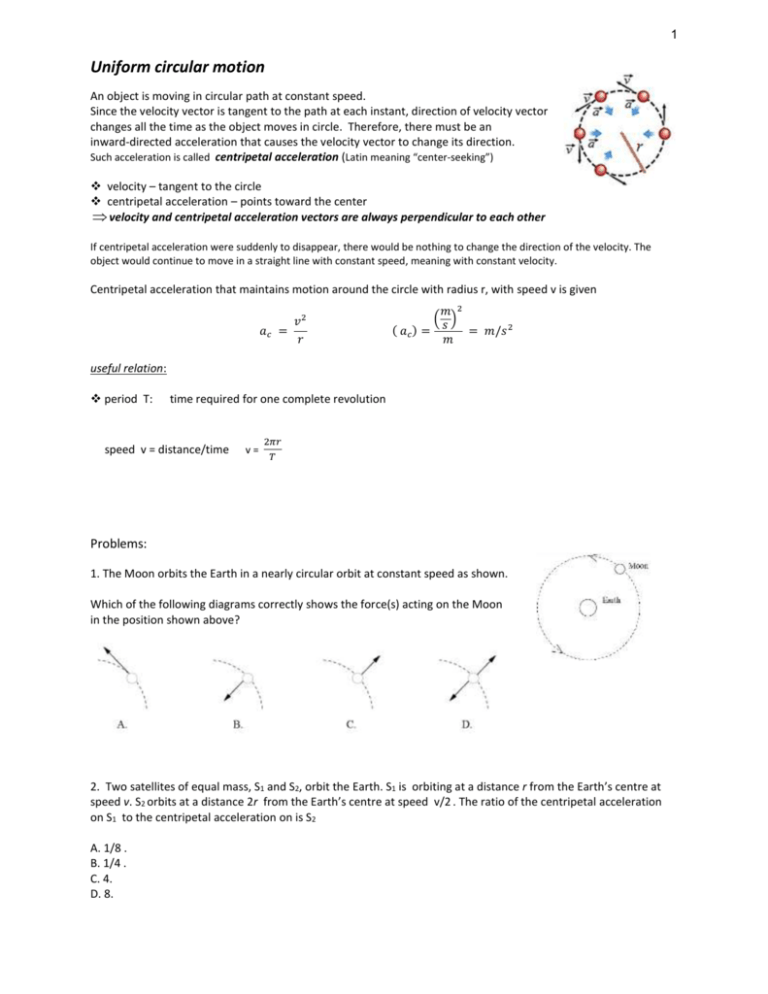
1 Uniform circular motion An object is moving in circular path at constant speed. Since the velocity vector is tangent to the path at each instant, direction of velocity vector changes all the time as the object moves in circle. Therefore, there must be an inward-directed acceleration that causes the velocity vector to change its direction. Such acceleration is called centripetal acceleration (Latin meaning “center-seeking”) velocity – tangent to the circle centripetal acceleration – points toward the center velocity and centripetal acceleration vectors are always perpendicular to each other If centripetal acceleration were suddenly to disappear, there would be nothing to change the direction of the velocity. The object would continue to move in a straight line with constant speed, meaning with constant velocity. Centripetal acceleration that maintains motion around the circle with radius r, with speed v is given 𝑣2 𝑎𝑐 = 𝑟 𝑚 2 ( ) ( 𝑎𝑐 ) = 𝑠 = 𝑚/𝑠 2 𝑚 useful relation: period T: time required for one complete revolution speed v = distance/time v= 2𝜋𝑟 𝑇 Problems: 1. The Moon orbits the Earth in a nearly circular orbit at constant speed as shown. Which of the following diagrams correctly shows the force(s) acting on the Moon in the position shown above? 2. Two satellites of equal mass, S1 and S2, orbit the Earth. S1 is orbiting at a distance r from the Earth’s centre at speed v. S2 orbits at a distance 2r from the Earth’s centre at speed v/2 . The ratio of the centripetal acceleration on S1 to the centripetal acceleration on is S2 A. 1/8 . B. 1/4 . C. 4. D. 8. 2 3. What acceleration will keep a car to go around a circle of radius of 20 m in 5 s? 4. A ball of mass M at the end of a string is swung in a horizontal circular path of radius r at constant speed v. Which combination of changes would require the greatest increase in the centripetal acceleration acting on the ball? a) doubling v and halving r b) halving v and doubling r c) halving v and halving r d) doubling v and doubling r 5. Centripetal acceleration ac acts on a car going around a curve. If the speed of the car were twice as great, the magnitude of the centripetal acceleration necessary to keep the car moving in the same path would be a) 2 ac b) ac c) ac/2 d) 4 ac 6. A child is riding on a merry-go-round. As the speed of the merry-go-round is doubled, the magnitude of the centripetal acceleration acting on the child a) remains the same b) is quadrupled c) is doubled d) is halved 7. What centripetal acceleration does a car need to go around a 265 m radius corner at 83 km/h? 8. If it takes a centripetal acceleration of 1.336 m/s2 for a car to go around a corner at 62 km/h, what is the radius of curvature of the corner? 1. B 5. d 2. A 6. b. 3. v = 7. 𝑎𝑐 = 2𝜋𝑟 𝑇 𝑣2 𝑟 = = 2𝜋(20) 5 232 265 = 25 m/s = 2.0 𝑚/𝑠 2 𝑎𝑐 = 𝑣2 𝑟 = 31 𝑚/𝑠 2 8. 𝑟 = 222 m 4. a) 3



